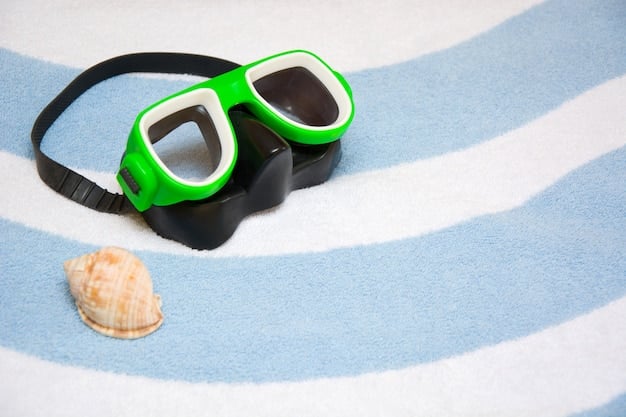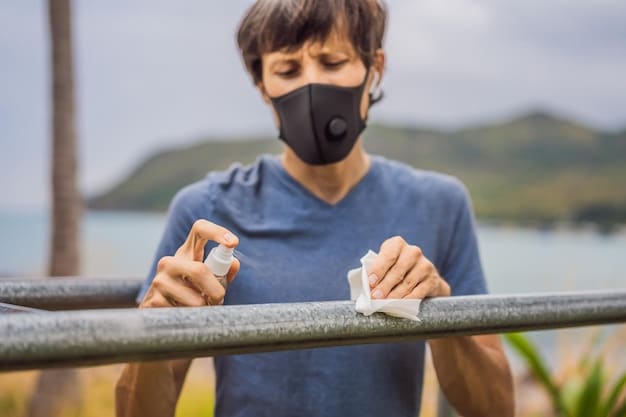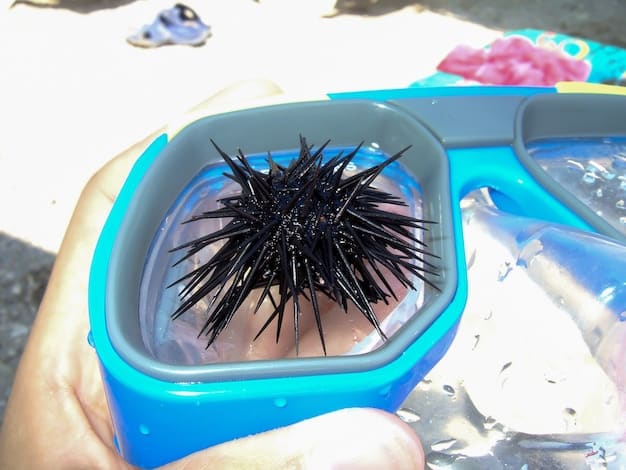Snorkeling Gear Maintenance: Extend Equipment Life by 50%

Effective Snorkeling Gear Maintenance: Extend the Life of Your Equipment by 50% with These Simple Steps outlines crucial post-dive cleaning, proper storage techniques, and routine inspections that significantly prolong functionality and enhance safety for enthusiasts.
Diving into the underwater world with a well-maintained snorkel set can transform an ordinary swim into an extraordinary adventure. The longevity and performance of your equipment, from the mask sealing perfectly to the fins propelling you effortlessly, hinges on diligent Snorkeling Gear Maintenance: Extend the Life of Your Equipment by 50% with These Simple Steps. This isn’t just about preserving your investment; it’s about ensuring safety and comfort every time you explore the vibrant marine ecosystem.
Understanding the Elements: The Enemies of Your Snorkeling Gear
Before delving into specific maintenance routines, it’s crucial to understand the primary adversaries your snorkeling gear faces. The marine environment, though beautiful, is relentlessly harsh on equipment. Saltwater is a corrosive agent, capable of degrading various materials over time, while UV radiation from the sun can weaken plastics and rubber. Even seemingly benign fresh water, if not properly evacuated, can foster microbial growth.
Beyond these natural elements, mechanical stresses play a significant role in wear and tear. Constant bending and stretching, impacts, and friction from sand or abrasive surfaces contribute to fatigue and structural damage. Understanding these factors informs the rationale behind each maintenance step, transforming simple actions into calculated preservation efforts.
Saltwater: The Primary Corrosive Agent
Saltwater’s high salinity makes it an aggressive medium for metals and certain plastics. It can lead to the oxidation of metal components, such as those found in fin buckles or mask straps, resulting in rust and structural weakening. For silicone and rubber parts, salt residue can cause a loss of elasticity, leading to cracking and reduced sealing capabilities. The crystalline structure of dried salt can also become abrasive, especially when gear is folded or stored without thorough rinsing.
- Causes rust and corrosion in metal parts.
- Leads to loss of elasticity and cracking in silicone/rubber.
- Deposits abrasive salt crystals when dry.
This corrosive action underscores the immediate need for freshwater rinsing after every use. Delaying this simple step allows salt to penetrate material pores, accelerating degradation. The extent of the damage might not be immediately apparent, but over successive uses, the cumulative effect can drastically shorten the lifespan of your gear, affecting both its performance and your safety.
UV Radiation: The Silent Degrader
Sunlight, particularly its ultraviolet (UV) component, is another significant threat. UV rays break down the chemical bonds in polymers, such as the silicone in masks and snorkels, and the plastic in fins. This degradation manifests as fading, brittleness, and a general weakening of the material. A clear mask skirt might turn yellow and opaque, while fin blades can become stiff and prone to cracking.
Prolonged exposure to direct sunlight, even when the gear is not in use, can dramatically reduce its lifespan. Therefore, proper storage, away from direct sunlight, is just as important as post-use cleaning. This preventive measure mitigates the cumulative damage that UV radiation inflicts, helping maintain the integrity and appearance of your equipment.
In essence, protecting your gear from these environmental aggressors is the foundational principle of effective maintenance. Each subsequent step detailed in this guide builds upon this understanding, aiming to neutralize these threats and preserve the optimal condition of your snorkeling equipment.
Immediate Post-Dive Care: The First Line of Defense
The moment you exit the water, your maintenance routine truly begins. Immediate post-dive care is perhaps the most critical step in preserving your snorkeling equipment. Neglecting this initial phase allows corrosive elements to take hold, accelerating wear and tear. This isn’t just about a quick rinse; it’s a systematic approach to neutralizing the immediate threats posed by saltwater, sand, and other marine debris.
Think of it as preparing your gear for its next adventure, ensuring it’s as ready and reliable as it was when brand new. This initial process focuses primarily on thorough rinsing and gentle cleaning, removing all significant contaminants before they can cause lasting damage.
Rinsing Your Gear Thoroughly
The cornerstone of immediate post-dive care is a comprehensive rinse with fresh water. Ideally, this should be done as soon as possible after leaving the ocean or pool. Use cool or lukewarm freshwater to flush away all traces of salt, sand, dirt, and chlorine. Pay particular attention to crevices, buckles, and adjustable straps where salt crystals and sand particles can accumulate and become abrasive.
For your mask, fill the skirt with water and swish it around, then rinse the lenses and strap. For the snorkel, run water through both ends to ensure the mouthpiece and barrel are clear. Fins should be rinsed thoroughly, focusing on the foot pockets and any quick-release buckles. A brief soak in a tub of fresh water for 15-20 minutes can also be beneficial, allowing any embedded salt to dissolve.
- Use cool or lukewarm fresh water.
- Flush all components, especially crevices and buckles.
- Consider a brief soak for comprehensive salt removal.
Remember, simply dipping your gear in water is insufficient. The goal is to actively wash away all residues, ensuring no salt crystals remain to cause damage as the gear dries. This diligent rinsing significantly mitigates the corrosive impact of saltwater on all components.
Gentle Cleaning Techniques
While rinsing removes most loose contaminants, a gentle cleaning may be necessary to address more stubborn residues, such as sunscreen, body oils, or algae buildup. Use a mild soap or a specialized gear cleaner if available. Avoid harsh detergents, abrasive scrubs, or solvents, as these can strip protective coatings, damage silicone, or degrade plastic components.

When cleaning your mask, use a soft cloth or sponge on the lenses and skirt. For the snorkel, a small brush can help clean the inside of the barrel and the mouthpiece. Fins usually only require a thorough rinse and perhaps a wipe down. Always follow the manufacturer’s recommendations for cleaning agents and methods to avoid inadvertently damaging your equipment. This gentle approach ensures that while contaminants are removed, the integrity of the materials is preserved.
By implementing these immediate post-dive care steps, you establish a strong foundation for the long-term preservation of your snorkeling gear. Skipping this crucial phase can lead to irreversible damage and significantly shorten the functional lifespan of your equipment, making future adventures less enjoyable and potentially less safe.
Thorough Drying: Preventing Mold and Material Degradation
Once your snorkeling gear is clean, the next vital step is thorough drying. This phase is often overlooked but is paramount in preventing the growth of mold and mildew, which can degrade materials and produce unpleasant odors. Proper drying also ensures that any remaining moisture doesn’t promote corrosion or material breakdown during storage. It’s about preparing your gear for its dormant period, ensuring it emerges in optimal condition for its next use.
Air Drying Best Practices
After rinsing and cleaning, allow your gear to air dry completely. The key is to do this in a cool, shaded, and well-ventilated area. Never dry your gear in direct sunlight. As discussed, UV radiation is detrimental to plastics and silicone, causing them to become brittle, yellow, and lose elasticity. Hanging masks and snorkels can help water drain effectively, while fins can be placed on a flat, clean surface or hung by their foot pockets, ensuring good air circulation around all surfaces.
For masks, ensure the skirt is fully expanded to allow air to circulate around its edges. For snorkels, make sure any purge valves are cleared of water. Shake out any excess water from all components before setting them to dry. It’s crucial that all parts, especially internal ones and crevices, are completely dry to prevent any moisture retention that could lead to issues. This may take several hours, so patience is key.
Checking for Residual Moisture
Before storing your gear, always perform a final check for any lingering moisture. Pay close attention to areas where water can easily collect, such as inside the mask skirt, the snorkel’s mouthpiece, or the foot pockets of fins. Even a small amount of trapped moisture can create a breeding ground for mold and mildew, leading to unpleasant smells and potential damage to the materials. This final inspection ensures that your efforts in cleaning and drying are not undermined by oversight.
- Thoroughly inspect all crevices and internal parts.
- Ensure mask skirts are fully dry and expanded.
- Check snorkel valves and fin foot pockets meticulously.
If you find any damp spots, simply allow the gear more time to air dry. Rushing this process by using heat (like a hairdryer) is not recommended, as excessive heat can deform materials or compromise their integrity. The goal is complete dryness achieved naturally. By mastering the art of thorough drying, you significantly prevent material degradation, odor issues, and the need for premature replacements, extending the life of your snorkeling equipment by a considerable margin.
Proper Storage: Protecting Your Investment Long-Term
Once your snorkeling gear is meticulously cleaned and thoroughly dried, the final step in its long-term preservation is proper storage. This phase is about creating an environment that protects against environmental stressors and mechanical damage, keeping your equipment in prime condition for extended periods. Incorrect storage can undo all the diligent cleaning and drying efforts, leading to premature aging and material fatigue.
The objective is to shield your gear from elements like dust, direct sunlight, extreme temperatures, and physical compression that can deform or damage its delicate components. Thoughtful storage doesn’t just prolong life; it ensures your gear is ready to perform optimally the moment you decide to embark on your next aquatic adventure.
Ideal Storage Conditions
The ideal storage environment for snorkeling gear is cool, dark, and dry. This means away from direct sunlight, which, as previously discussed, can cause severe UV degradation to silicone and plastic. Avoid storing gear in areas prone to extreme temperature fluctuations, such as attics, garages without climate control, or vehicle trunks. High temperatures can accelerate the breakdown of materials, making them brittle, while extremely low temperatures can make them stiff and less pliable.
Humidity is another factor to consider; a dry environment prevents mold and mildew growth, even if your gear felt dry before storage. A dedicated gear bag or container that allows for some air circulation is preferable to an airtight plastic bag, which can trap any residual moisture and odors. For masks, consider storing them in a protective mask box to prevent lens scratches and skirt deformation.
Preventing Deformation and Compression
One of the most common causes of damage during storage is improper positioning that leads to deformation or compression. Mask skirts, particularly those made of silicone, can easily distort if stored pressed against an uneven surface or crushed under other items. This can compromise the seal, leading to leaks during future use. To prevent this, store masks with the skirt facing upwards or in a padded mask box that maintains its shape.
- Store masks in a protective box or face up.
- Hang fins or lay them flat without bending.
- Ensure snorkels are not compressed.
- Avoid placing heavy objects on top of gear.
Fins should be stored flat, ideally hanging vertically by the foot pocket or laid out without any bends or folds that could warp the blades. Snorkels should be laid out straight or gently coiled without tight bends, especially around the mouthpiece or flex sections, to prevent kinks or permanent deformation. Avoid stacking heavy items on top of your gear. By respecting the natural shape of each component and providing adequate space, you ensure that your gear retains its original form and functionality, ready for countless future explorations. Proper storage is the silent guardian of your snorkeling investment, contributing significantly to its long-term durability.
Routine Inspections: Catching Problems Before They Escalate
Beyond cleaning and proper storage, a proactive approach to maintenance involves routine inspections. This step is about vigilance—regularly checking your gear for signs of wear, damage, or degradation that might not be immediately obvious. Identifying and addressing minor issues early can prevent them from escalating into major problems that compromise performance, safety, or necessitate complete gear replacement. Think of it as a health check-up for your equipment, ensuring its continued reliability.
Checking for Wear and Tear
Before each use, and certainly periodically during the off-season, take the time to meticulously inspect every component of your snorkeling gear. Start with your mask: examine the silicone skirt for any cracks, tears, or signs of hardening. A compromised skirt will leak. Check the lenses for scratches or fogging issues that won’t clear. Inspect the strap for fraying or weakening, and ensure buckles function smoothly without sticking or breaking.

For your snorkel, examine the mouthpiece for bites, tears, or discoloration. Check the barrel for any cracks. If it has a dry top or purge valve, ensure these mechanisms move freely and are free of debris. Fins should be inspected for cracks or tears in the foot pockets, especially around the heel strap. Check the fin blades for excessive bending or stress marks, and ensure any quick-release buckles are intact and functional. Small tears or abrasions can quickly become larger problems when stressed in the water.
Addressing Minor Issues Promptly
Once identified, minor issues should be addressed without delay. A small tear in a mask skirt might be repairable with a specialized silicone adhesive, preventing a full mask replacement. A fin strap that shows signs of wear should be replaced before it snaps in the water, potentially leaving you without propulsion. Fogging issues on a mask might be resolved with a new anti-fog treatment rather than replacing the entire mask.
- Repair small tears with appropriate adhesives.
- Replace worn or frayed straps immediately.
- Apply anti-fog treatments for lens clarity.
- Lubricate sticky buckles if needed.
Sometimes, simply tightening a screw or lubricating a sticky buckle can resolve a minor performance issue. Prompt action not only saves you money in the long run but also ensures your safety and comfort during your underwater excursions. Ignoring these small signs can lead to equipment failure at the most inopportune times. By making routine inspections a consistent part of your snorkeling routine, you elevate your maintenance efforts from reactive repairs to proactive preservation, significantly extending the reliable life of your equipment.
Advanced Care Tips: Enhancing Longevity and Performance
While fundamental cleaning, drying, storage, and inspection routines form the backbone of snorkeling gear maintenance, certain advanced tips can further enhance the longevity and performance of your equipment. These practices move beyond the basics, offering insights into optimizing material integrity and addressing specific challenges that arise with extended use. They reflect a deeper understanding of material science and environmental impact, allowing for a more nuanced approach to care.
Adopting these advanced strategies demonstrates a commitment to truly maximizing your gear’s lifespan, ensuring it remains in peak condition for every aquatic adventure. These tips often involve specialized products or techniques that are simple to implement but yield significant long-term benefits.
Silicone and Rubber Conditioning
Silicone and rubber components, commonly found in mask skirts, snorkels, and fin straps, are susceptible to drying, hardening, and cracking over time due to exposure to UV, saltwater, and air. To combat this, consider periodically conditioning these parts with a silicone-based lubricant or a specialized rubber conditioner. These products help to restore the material’s pliability and prevent microscopic cracks from forming.
Apply a small amount to a clean cloth and gently wipe down all silicone and rubber surfaces. Ensure the product is safe for use on dive equipment and does not contain petroleum-based ingredients, which can actually degrade silicone. Regular conditioning, perhaps once every few months or before long-term storage, keeps your mask skirt soft and sealing effectively, and your snorkel and fin straps flexible and comfortable. This proactive approach significantly extends the material’s elasticity and overall lifespan.
Defogging and Lens Care
A fogging mask is a common frustration for snorkelers. While anti-fog sprays are readily available, proper lens care goes beyond just applying a defogger. For new masks, the lenses often come with a manufacturing residue that causes persistent fogging. A common and effective method to remove this is to gently rub a small amount of non-abrasive toothpaste (not gel toothpaste) on the inside of the lenses with your finger, then rinse thoroughly. Repeat a few times. This mild abrasive action buffs away the residue without scratching. Always avoid touching the inside of your mask lenses with your fingers once cleaned, as skin oils can cause fogging.
- For new masks, use non-abrasive toothpaste to remove manufacturing residue.
- Always rinse lenses thoroughly after use to remove salt and debris.
- Apply anti-fog solution just before each dive.
- Store masks in a protective box to prevent scratches.
For ongoing clarity, apply a commercial anti-fog solution or even a drop of baby shampoo diluted with water to the inside lenses before each use. Rub it in and rinse lightly. This creates a thin film that prevents condensation from forming droplets. Always store your mask in a protective case to prevent lens scratches, which can be irreparable and affect visibility.
Addressing Specific Material Issues
Different materials within your gear might require specific attention. For neoprene accessories like wet suits or rash guards, proper rinsing and air drying are crucial to prevent mildew. Store them on wide hangers to maintain their shape, avoiding thin wire hangers that can deform the material. For plastic components, if you notice any minor scuffs, some plastic polishing compounds can help restore their clarity or finish, though this is mostly cosmetic.
For any metal parts, such as buckles or clips, while generally corrosion-resistant, a tiny drop of silicone grease periodically can ensure smooth operation and provide an extra layer of protection against saltwater ingress. These targeted interventions, though seemingly small, contribute significantly to the overall health and extended operational life of your entire snorkeling kit, allowing you to focus on the underwater wonders rather than equipment worries.
Common Pitfalls to Avoid: What Not to Do
While knowing what to do for snorkeling gear maintenance is essential, understanding what *not* to do is equally critical. Certain common habits or oversights can rapidly accelerate the degradation of your equipment, undermining even the best maintenance efforts. Avoiding these pitfalls can prevent unnecessary wear, damage, and ultimately, prolong the utilitarian life of your gear significantly beyond typical expectations.
These are often actions born of convenience or a lack of awareness, but their cumulative impact can be severe. By consciously sidestepping these detrimental practices, you safeguard your investment and ensure your snorkeling adventures remain enjoyable and hassle-free.
Leaving Gear in the Sun to Dry
Perhaps the most prevalent and damaging mistake is leaving your snorkeling gear, especially masks and snorkels, in direct sunlight to dry. While the sun appears to be an efficient drying agent, the intense UV radiation it emits is a silent but powerful enemy of silicone and plastic. UV rays break down the polymers in these materials, leading to accelerated aging, brittleness, yellowing (in clear silicone), and a loss of elasticity.
A mask skirt left in the sun will quickly stiffen and lose its ability to create a proper seal, leading to leaks. Snorkel mouthpieces will become hard and uncomfortable, prone to cracking. Fins, too, will become brittle and lose their flexibility, making them less efficient for propulsion and more susceptible to snapping. Always air dry your gear in a cool, shaded, and well-ventilated area, away from direct sunlight, to prevent this irreversible damage.
Using Harsh Chemicals or Abrasive Cleaners
The temptation to use strong detergents, abrasive cleaners, or even household chemicals to clean stubborn residue might arise, but this is a critical mistake. Products containing solvents, petroleum derivatives, or strong bleaching agents can severely damage the delicate materials of your snorkeling gear. They can strip protective coatings, cause silicone to swell or degrade, and make plastics brittle.
- Avoid bleach, acetone, and petroleum-based cleaners.
- Do not use abrasive sponges or scrub brushes on lenses or silicone.
- Stick to mild, pH-neutral soaps or specialized gear cleaners.
For example, using dish soap with strong degreasing agents too frequently can dry out silicone over time. Abrasive sponges or brushes can scratch mask lenses and the highly polished surface of silicone skirts, creating microscopic channels that actually encourage fogging or harbor trapped salt. Stick to mild, pH-neutral soaps and soft cloths or sponges for cleaning. When in doubt, plain fresh water is always the safest option.
Storing Gear Wet or Compressed
Storing gear that is even slightly damp is an open invitation for mold, mildew, and unpleasant odors. Mold not only smells bad but can also degrade the fabric straps and even the silicone components over time. This is why thorough drying is so crucial before storage.
Equally damaging is storing gear in a way that compresses or deforms its original shape. Masks stored with the skirt folded or pressed against something will develop permanent creases, compromising their seal. Fins crammed into tight spaces can warp their blades. Snorkels bent into unnatural positions will develop kinks. These deformations can be very difficult, if not impossible, to reverse, leading to performance issues and discomfort during use. Invest in proper storage solutions, like mask boxes and dedicated gear bags, to allow your equipment to rest in its natural, uncompressed state. Avoiding these common pitfalls ensures your snorkeling gear remains functional, comfortable, and aesthetically pleasing for many seasons to come, truly extending its life by a significant margin.
Final Thoughts on Extending Your Gear’s Lifespan
Extending the life of your snorkeling equipment by 50% isn’t an exaggeration; it’s a realistic outcome of consistent, thoughtful maintenance. This journey from the excitement of a new purchase to the reliable performance of well-cared-for gear hinges not on complex procedures, but on adherence to simple, logical steps. From the immediate freshwater rinse that neutralizes corrosive saltwater to the meticulous drying that combats mildew, and from the conscientious storage that preserves shape to the vigilant inspections that catch minor issues, each action plays a vital role.
The cumulative effect of these practices is undeniable. A mask that seals perfectly time after time, fins that retain their propulsive efficiency, and a snorkel that remains clear and comfortable are not just a matter of luck, but a direct result of dedicated care. Beyond the financial savings of not needing frequent replacements, proper maintenance ensures your safety and enhances your enjoyment of the underwater world. When your gear performs as intended, your focus remains on the vibrant marine life, the serene blue depths, and the pure joy of discovery.
Remember that your snorkeling equipment is an investment in countless future adventures. Treat it with the respect it deserves, and it will, in turn, serve you faithfully for years to come. By embracing these straightforward maintenance principles, you not only preserve your gear but also deepen your connection to the ocean, confident that your equipment is always ready for the next dive.
| Key Maintenance Point | Brief Description |
|---|---|
| 💧 Immediate Rinse | Rinse all gear thoroughly with fresh water right after use to remove salt and chlorine. |
| ☀️ Shaded Drying | Always air dry gear completely in a cool, shaded, well-ventilated area to prevent UV damage and mold. |
| 📦 Smart Storage | Store gear in a cool, dry, dark place, preventing compression and direct sunlight exposure. |
| 🔍 Regular Checks | Periodically inspect for wear, cracks, or damage, addressing minor issues promptly to prevent escalation. |
Frequently Asked Questions About Snorkeling Gear Maintenance
▼
You should rinse your snorkeling gear thoroughly with fresh water immediately after every single use, whether in salt or fresh water. A more thorough cleaning with mild soap should be done periodically, perhaps after every few uses or if you notice significant residue accumulation. Always ensure it’s completely dry before storing.
▼
While a very mild, non-detergent dish soap can be used sparingly for a deeper clean, avoid harsh or strongly degreasing dish soaps. These can strip protective coatings or dry out silicone over time. It’s best to opt for specialized gear cleaners or simply fresh water for routine cleaning to maintain material integrity.
▼
For new masks, gently rub non-abrasive toothpaste on the inside lenses to remove manufacturing residue, then rinse well. Before each use, apply a commercial anti-fog solution or a drop of baby shampoo, then lightly rinse. Avoid touching the inside lenses with your fingers, as skin oils cause fogging.
▼
Absolutely not. Storing wet gear in a bag creates a perfect environment for mold and mildew to grow, leading to unpleasant odors and material degradation. It can also accelerate corrosion of any metal parts. Always ensure all components are completely dry before storing them, ideally in a well-ventilated space.
▼
It’s advisable to perform a quick visual inspection before every use. For a more thorough check, inspect your gear periodically throughout the season and always before long-term storage or before the start of a new snorkeling season. This proactive approach helps catch minor issues before they become serious problems.
Conclusion
Maintaining your snorkeling gear is not merely a chore; it’s an essential ritual that directly impacts the longevity, performance, and safety of your aquatic adventures. By consistently applying simple yet effective steps—like immediate rinsing, thorough shaded drying, thoughtful storage, and routine inspections—you actively extend the lifespan of your equipment significantly. This diligent care ensures that your mask seals perfectly, your fins propel you effortlessly, and your snorkel remains clear and comfortable, allowing you to immerse yourself fully in the beauty of the underwater world. Investing time in proper maintenance is investing in countless more memorable explorations.





